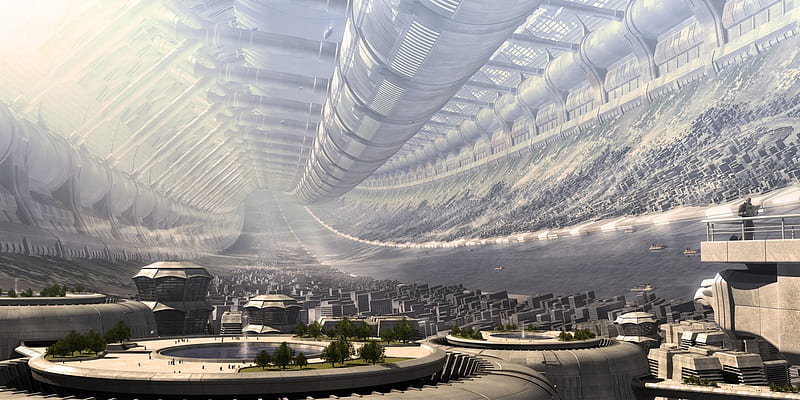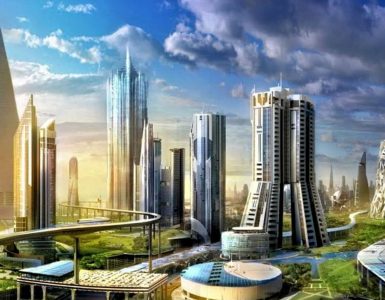by A’liya Spinner
A City Beneath Glass
Anita locks her front door behind her as she steps outside, swinging her purse up onto her shoulder and squinting slightly in the sun. It streams down in warm beams through a curved, glass dome overhead, illuminating a bustling, underground world, waking up around her as the sounds of machinery, voices, and the general hum of society echoed across the giant pit at the center of the Earth-scraper. Once, it had frightened Anita to walk outside her apartment and see a gaping chasm (behind a reinforced safety rail, of course), but once she’d started her new job at an office near the lowest levels, she was grateful for it— even that deep underground, it’s nice to see sunlight streaming down from above.
Content, she begins her walk to the large, communal elevators that connect residential levels to the rest of the structure— there’s a high-speed train that rings each story of the Earth-scraper for those who dislike walking, but she enjoys the morning stroll. The central shaft of the Earth-scraper guides a pleasant breeze that warms her skin and flutters huge, rippling banners overhead. Some are advertisements for new shops in the lower rings, but others are merely decorations, colorful and holiday-themed for the season. Ribbons have been tied around the rail, and giant ornaments hang from the edges of the glass-domed ceiling; Anita appreciates the effort to make the Earth-scraper feel more like a community enthused with the spirit of celebration. The first years of living there, she sometimes felt like a troglodyte in a high-tech cave, surrounded by nothing but drab metal and stone and the monotony of everyday life. Now, it’s much more pleasant.
There’s a spring to her step as she walks, checking her phone for any texts or emails. None yet, which is fine by her. She likes her morning walks uninterrupted, before a busy day of work in the lower levels. A particularly strong gust of wind— churned by huge air purifiers built into the infrastructure of the Earth-scraper— brushes past her, and she pauses. And sneezes. And then sneezes again, covering her mouth with her sleeve.
“Allergies?”
When she regains control of herself, Anita looks up and spies one of her friendliest neighbors, stopped beside her on the walkway and dressed in scrubs; vaguely, she remembers that he works at the urgent care in the middle of Earthscraper, taking emergency patients that don’t have the time or severity to go to the surface. She laughs and nods.
“Unfortunately,” she replies, surreptitiously wiping her nose. “The green levels are all in full bloom— in December.” She glances up, towards the higher stories of the Earthscraper, full of gardens that provided not only fresh food and fresh air, but a frequent supply of pollen.
“I guess nobody told the plants it’s winter on the surface,” he answers. “Sometimes I forget, too. I went topside the other day and forgot my coat— nearly froze my fingers off.”
“Tell me about it.” Anita nods, relating to the feeling of living in another world, separate from the crowded bustle of the surface. Most of her life and work was in the Earthscraper, its own little community of people, things to do, and places to see.
“Are you heading to the elevators?” Her neighbor begins to walk, pointing to a distant crowd of people that they would soon be joining.
“Yeah, I’ll walk with you,” she answers, falling into place beside him. The warm air of the Earthscraper moved slowly around them, like the breath of a giant buried beneath the surface, starting to stir with a new form of life below the ground.
Moving Underground
Infrastructure beneath the ground is nothing new. Many urban centers use underground train systems to facilitate public transport, an idea first proposed in 1843, for the city of London. Though the first subways were destructive to build (requiring roads to be dug up and then recovered) and released noxious fumes, they were also immediately successful at transporting millions of people. As they became safer to ride and easier to build, the novel subway spread rapidly across Europe, and soon the rest of the world. Modern underground infrastructure is also utilized in sewage systems, pipes and cables, storage, and maintenance access— but rarely do we see large, habitable houses, offices, or tourist destinations underneath the ground.
Yet life underground isn’t as foreign as it might seem— over forty subterranean cities have been discovered around the world, such as Derinkuyu, an underground Turkish city that may have once held 20,000 people at its height in 800 BC. Near Derinkuyu is a potentially even larger site dating back 5,000 years, yet to be fully uncovered and studied. These cities— complete with homes, room for livestock and crops, and recreation— were not buried by volcanic eruptions or tectonic movement; these were intentional, subsurface settlements that have persisted for thousands of years. Now, they may be making a comeback, not for their defensive strength against foreign armies, but for their potential as a more climate-friendly solution to modern living.
When constructed well, subsurface homes are less destructive to the ecosystem around them. Solar panels are easily positioned to provide energy to homes, while the ground remains otherwise intact for grass, native plants, and wildlife traffic, and the unpaved soil acts as a natural drainage system. Heating and cooling costs also decrease thanks to the insulating quality of the ground, especially in extreme climates with low humidity. Earth-sheltered buildings are less prone to damage from natural disasters, particularly fires, hurricanes, and tornadoes, a potentially life-saving design in communities currently under duress from climate change causing an increase in dangerous weather and wildfire. And, though the initial construction cost is higher than a traditional home, a foundation of recycled concrete and stone makes the house studier, requires less upkeep overtime, and reduces dependency on wood. But some architects want to take it far beyond an underground suburb; one entry to the eVolo Skyscraper Competition proposed a self-sufficient, subterranean community in the desert.
The 900-foot deep structure would be covered by a skylight dome designed to blend non-invasively to the desert ecosystem. Then, below the surface, high terraces grow produce for the community with unfiltered access to the sunlight. Under them are homes, work areas, and recreation spaces, connected by an underground, high-speed rail to other, nearby settlements. And the structure itself acts as a thermal funnel, venting heat through the surface dome and regulating the temperature with much more ease than surface buildings in the desert. Similarly, in Mexico City, plans for an enormous, inverted “Earthscraper” have been unveiled. The underground structure is proposed to contain thirty-five stories of offices, housing, gardens, and a museum, circumventing the law that prevents skyscrapers from exceeding eight stories within city limits, and preserving the integrity of the historical, above-ground architecture near Mexico City’s central plaza. A glass “roof” provides natural light to many (though likely not all) of the levels, while curated micro-ecosystems are designed to keep the air fresh and clean. The designer hopes that— despite the daunting 800 million dollar price tag— his Earthscraper, a “mini-city” in its own right, is the sustainable solution to population growth without uncontrollable urban sprawl.
Advancements in subsurface construction have already made these otherwise far-fetched ideas seem increasingly possible. In Ticino, Switzerland, the tunnel system connecting a hydroelectric power-plant to its water source received a complete overhaul, located entirely underground to avoid disrupting the natural landscape. Despite passing through porous, water-filled layers and weak zones of loose rocks, innovative technology allowed the tunnel to be evacuated and sealed against leaks without contaminating the natural aquifers, or disturbing the forest above construction. Though a singular instance, the Ticino corridor was a pioneer in the sustainable refurbishment of preexisting infrastructure, and a possible blueprint for the underground tunnel and piping systems needed to support an inverted Earthscraper neighborhood.
Architectural Pipedreams?
Of course, as with any feat of complex engineering and infrastructural change, there are plenty of challenges that we are faced with, both on an architectural and sustainability scale. Small, residential homes and larger, city-scale Earthscrapers are faced with different obstacles, but ultimately may share some of the same solutions. And, perhaps most importantly (and yet impossible to fully address), how will these buildings retain the feeling of “home”? Can you have neighbors, or a neighborhood, when all homes are covered by wildlife and hidden in the landscape? Can an Earthscraper beneath Mexico plaza still participate in military parades, festivals, and daily, interconnected city life? Such questions must also be considered, alongside the engineering plans, because no matter how eco-friendly buildings may be, families, communities, and retailers will not want to inhabit them if they do not also feel like proper homes, worthy of the cost and effort associated with them. But how close are we to this dilemma— how likely are we to see a significant shift towards subsurface architecture in our lifetimes?
Subterranean Houses
Small, Earth-sheltered homes are already a novelty that have been built around the world, and are safely lived in by architectural enthusiasts and tourists. However, there are still concerns many have when considering an underground house. In particular, many homeowners worry about ventilation— lack of windows and airflow can cause the air to get stale or contaminated, so structures must maintain surface access and be engineered for fast exchange of interior and exterior air, which will require above-ground maintenance. Access to light is another necessity that requires careful consideration of surface area— a balance of windows and solar panels at the top of the house will help balance natural sunlight with eco-friendly electricity, to power UV-lamps and interior light to keep occupants healthy and well-illuminated. Of course, more glass above the surface will prevent seamless integration into the natural landscape, but even that is significantly less invasive to the ecosystem than a traditional home.
The other major barrier in the normalization of Earth-sheltered houses is concern for the type of soil available for construction. Granular soil makes the best ground-type for construction, allowing water to filter and drain easily around the home. In thick, non-porous soils, like clay or permafrost— or in areas of high humidity— the risk of interior leaking or condensation increases. And ground that is too loose can be unsafe to build a foundation in or on without sinking, similar to surface infrastructure. This makes the global application of these homes more limited, particularly in areas without access to the more expensive or eco-friendly building materials that create the foundations of many Earth-submerged homes. Hopefully, as techniques to build and integrate these buildings more seamlessly into the ground develop, their popularity, ease, and cost-effectivity will spread to a wider variety of land and countries.
Earthscrapers
The true architectural difficulty accompanies the construction of the “Earthscrapers”, intended to house many people, as well as provide versatile spaces capable of working, growing plants, and facilitating inevitable tourism. They are expensive and disruptive to build, require significant investment of materials and work hours, and, as of now, there is no fully operational model of success in the world. They also face more exacerbated versions of the difficulties faced by residential buildings; in hotter climates, will the beating sun combined with the bustle of machines and thousands of people create more heat than the structure can naturally dissipate, and how can a structure 35-stories deep remain well ventilated? Some of these issues can be addressed with the inclusion of “green rings” of high-oxygen producing plants, which lower temperatures and clean the air. But even this raises the question of how to efficiently conserve and recycle water in such a massive complex, especially if built in the desert-like environments where they have some of the greatest potential to flourish.
All of these combine to create the biggest roadblock in a functioning, subsurface neighborhood: the logistics of keeping it running. The engineering is not beyond what we’re capable of with modern technology, and there are already governments interested in investing in these projects. There are even more proposals to repurpose and expand old mines into subsurface theme parks, hotels, and residential housing. Once built, however, how can it be sustained? In an isolated, desert environment, solar panels can provide power, but what about Mexico City’s crowded central plaza, or in climates that do not receive near-constant sunlight? Waste removal on an industrial scale— especially working against the force of gravity to reach preexisting processing centers at the surface. The mundane operation of such a structure could quickly become an unsustainable power demand, which defeats the central idea of an inverted skyscraper being cleaner and more eco-conscious, especially if it must draw on power generated by fossil fuels. There are some proposed solutions to these issues, such as using fiber optic systems to carry sunlight to the deepest levels of the structure, or drawing water directly from nearby underground aquifers through piping systems, which is then filtered “on-site” at a processing plant built into the Earthscraper itself. These, and other sustainability-related questions, will have to be addressed before building can even begin; otherwise, an underground neighborhood may have an overall negative impact on the environment that it was created to protect.









